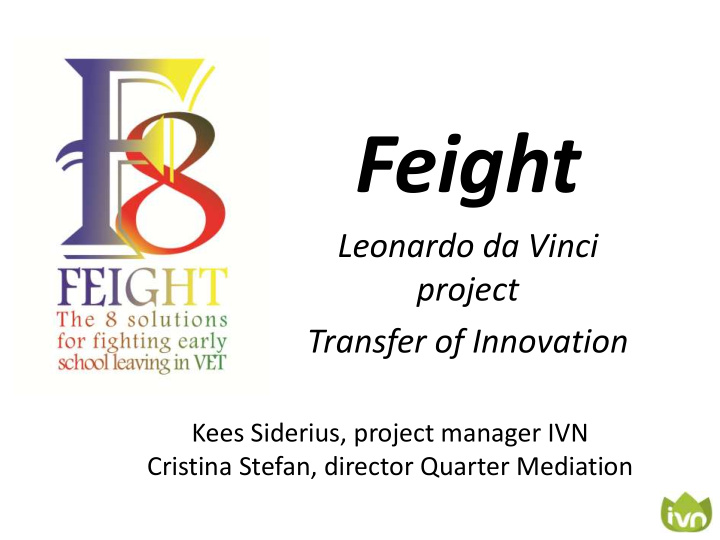



Feight Leonardo da Vinci project Transfer of Innovation Kees Siderius, project manager IVN Cristina Stefan, director Quarter Mediation
Leonardo da Vinci project Fighting early school leaving • Transfer of innovation • VET Schools • 2 Years • 6 Partners in 4 countries • • Dimem, Turkey Adastra, UK (Wales) • • Nimem, Turkey Qmed, Netherlands • • Shalom, Italy IVN, Netherlands
Leonardo da Vinci project Fighting early school leaving • Too many students leave school without qualification • Schools/teachers must identify students in risk of drop out and prevent them leaving • Feight helps identify these risks • Feight provides solutions • Feight increases the motivation of students (and teachers)
IVN = Dutch Institute for Nature education and Sustainability - NGO - National organization - 12 regional offices - 20.000 volunteers - 100 professionals - Various projects and activities on nature, landscape, environment and sustainability - Primary Schools - Secondary Schools - Civilians - 20 National Parks
Contribution IVN to Feight ‘Schools for Sustainability ’ program • Flexible program for secondary schools and VET schools • Local, regional, national projects every year • Network with enthusiastic teachers • 25% of all secondary schools
Contribution IVN to Feight In a ‘Schools for Sustainability’ project - Students work as consultants for a real client. - Their assignment is to explore a topic, and do - research , excursions, client visit, interview experts. - Students are encouraged to use other skills - In an official end presentation - the students present creative solutions for the client’s problem
Contribution IVN to Feight ‘Schools for Sustainability’ features: - Real assignment with a real client - Methodology Storyline Approach - Projects adjustable to every student level - Teacher training + Teacher handbook - Official end presentation
Contribution IVN to Feight Important: - Role of the teacher: as coach - Personal development of a student as: researcher, interviewer, constructor, coordinator, designer, presenter, artist, etc - Students discover different skills - Teachers recognize and support
Feight project We made a combination of: - Schools for Sustainability method (Netherlands) - Peer group method (UK) - Multiple Intelligence (Mr. Howard Gardner, 1983)
Fighting early school leaving with 8 solutions Schools / teachers can work with: 1. Working with real assignments 2. Using outdoor activities and training in nature 3. Extracurricular activities (e.g., music, dance, crafts, arts) 4. Peer training 5. E-learning 6. Using music, art, play, drama as teaching methods 7. Soft skills (team building, team working, communication) 8. Learning by doing in VET, in a real-life situation
Feight project - Start: sharing information among partners (Feb 2013) - Trainings in the Netherlands and UK - Pilot projects in VET schools in Turkey, Italy and the Netherlands - Evaluation (University of Amsterdam): - Great potential - Teacher trainings important (sharing) - Increased motivation students and teachers - Too short to measure results
Example 1 – annoyed student (The Netherlands) - An annoying, rude and cross student; she was difficult to handle in the classroom - In a real assignment project she volunteered to be the consultancy director; she managed the class during the 2 week project (sustainable building) - She coordinated a perfect end presentation and got high praise from client and teachers - She finished school without problems 1. Working with real assignments 7. Soft skills (team building, team working, communication)
Example 2 – drop out dj (UK) - A drop out student (16 years) already had left school - In a youth project he learned to be a music dj – and he was good at it - He could get a contract at a local discotheque on the condition that he went back to school - He became a succesful dj and finished school 4. Peer training 6. Using music, art, play, drama as teaching methods
Example 3 – unmotivated (Turkey) - Group of students with no idea of a future occupation - Project with real assignment (‘Design a new mosque with surrounding area’) - Students worked together with architects and builders - They presented creative ideas – some were used - Students more motivated and finished school 1. Working with real assignments 7. Soft skills (team building, team working, communication) 8. Learning by doing in VET, in a real-life situation
Outcomes Feight project • Project website www.ldvfeight.eu • Examples of innovative teaching and training approaches for reducing early school leaving in VET • Training package for peer training for teachers • Guidelines to set up a project with a real assignment • Quality Procedures for reducing drop-outs in VET • Available December 2014
Thank you for your attention!
Recommend
More recommend